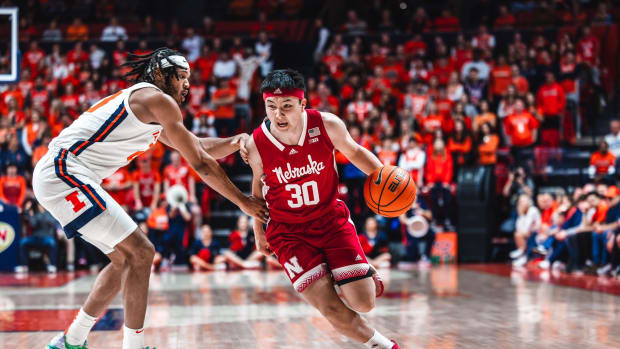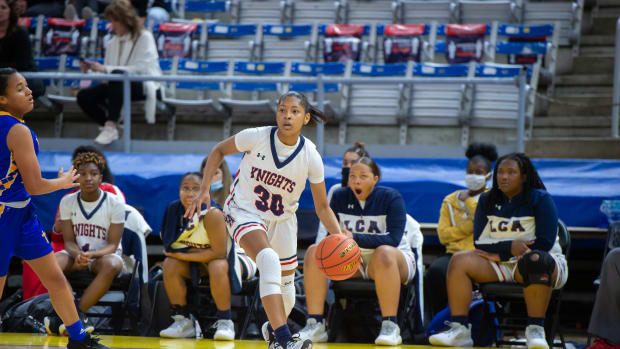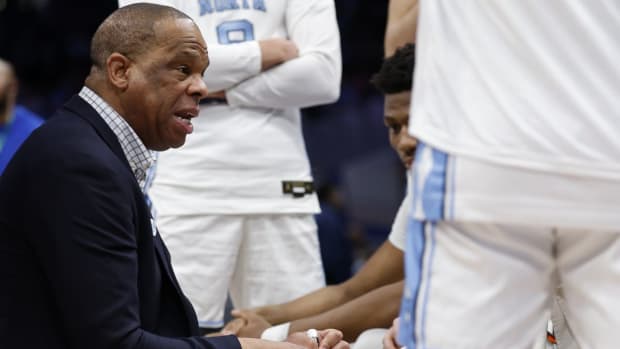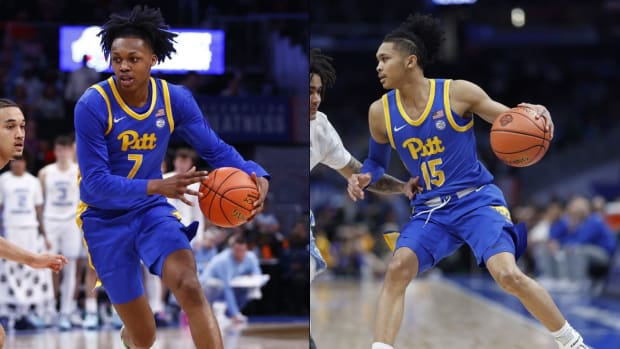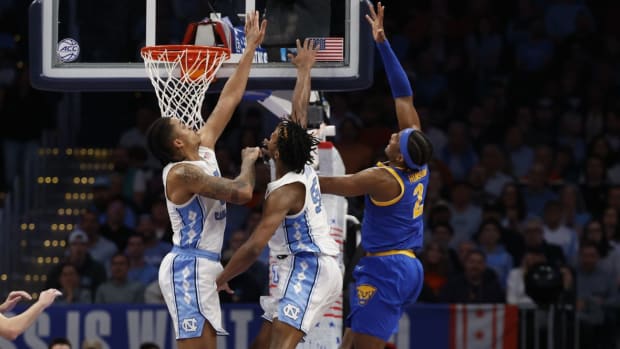Breaking Down the Prosecution's Wire Fraud Case in College Basketball's Corruption Trial
The first two weeks of the three-week college basketball corruption trial have all but confirmed what many long suspected: top college basketball recruits have been paid thousands of dollars in secret transactions. These payments, some of which were made to recruits’ family members, were structured as inducements to attend particular colleges sponsored by Adidas. The three defendants in the trial—Adidas director of global marketing James Gatto, Adidas consultant basketball organizer Merl Code and client recruiter (a.k.a. runner) Christian Dawkins—are all accused of masterminding various conspiracies to funnel payments to recruits or their families. The fate of these three men will be determined by 12 jurors who have been watching federal prosecutors from the Southern District of New York and defense attorneys debate the merits of the case before the presiding judge, U.S. District Judge Lewis Kaplan, in Manhattan’s Daniel Patrick Moynihan Courthouse.
If this trial was about proving the existence of corruption in “big time” college basketball, the government would have already proved its case beyond a reasonable doubt. A number of witnesses have detailed the extent and pervasiveness of such corruption.
Foe example, former Adidas consultant and AAU coach T.J. Gassnola testified that he played a facilitating role in transmitting five-figure payments to top recruits and/or their families. He named Deandre Ayton, Billy Preston, Silvio De Sousa, Brian Bowen and Dennis Smith as direct or indirect recipients of payments and asserted that the defendants possessed knowledge of such activities. As detailed in other SI articles, these five players have been linked to the case for months. In March, SI revealed that while media reports claimed Arizona head coach Sean Miller sought to pay Ayton $100,000, no such payment occurred. Consistent with SI’s reporting, Gassnola’s testimony did not implicate Miller and he referred to an alleged $15,000 payment to Ayton (who now plays for the Phoenix Suns) rather than one worth $100,000.
Gassnola also detailed his communications with Dawkins. Those communications included text messages in which Gassnola was critical of plans by persons connected with Adidas to pay Bowen and other recruits. Gassnola was also caught on government wiretaps speaking with Dawkins about Bowen. Bowen’s father, Brian Bowen Sr., also testified and admitted that a then-Louisville assistant coach, Kenny Johnson, paid him $1,300. As government witnesses, Gassnola and Bowen essentially cut deals with prosecutors: they agreed to share incriminating evidence and to testify against former colleagues and friends in exchange for not being prosecuted themselves.
Other witnesses have generated less attention but have nonetheless corroborated the idea that corruption is an on-going concern for college basketball officials. For example, N.C. State compliance director Carrie Doyle testified about her worries that former Wolfpack coach Mark Gottfried had possible ties to a runner who provided impermissible benefits to players. NC State is implicated due to the school’s recruitment of Smith, whose father was allegedly paid $40,000 by a runner as an inducement for his son to attend NC State. Smith played one year at NC State before declaring for the NBA in 2017 and being drafted in the first round by the Dallas Mavericks.
Deandre Ayton Named in College Basketball Corruption Trial, Family Friend Given $15,000
Revisiting the government’s theory of crime
While the trial has generated headlines in revealing scandalous details about high-profile basketball figures, generating headlines isn’t the goal of the federal prosecutors who have been entrusted with the government’s case. The case is neither designed to prove that corruption is rampant in college basketball nor establish that various persons have violated NCAA amateurism rules. Remember, amateurism rules aren’t laws. They are merely contractual requirements for admittance and subsequent compliance in the NCAA, a not-for-profit entity. It is not now, nor has it ever been, a crime to pay someone to attend a particular college.
With that in mind, some have ridiculed the Justice Department for prosecuting what appears to be violations of NCAA rules, rather than actual laws. Prosecutors, however, would dismiss such critiques as missing the core of their case. The Justice Department essentially has a two-prong theory of criminal conduct.
First, the Justice Department contends that payoffs to recruits defraud the universities that enroll those recruits. This might seem paradoxical: why would universities complain about enrolling superstar basketball players who were aggressively recruited by rival programs? The reason, the Justice Department argues, begins when the recruit accepts a payoff. It is at that moment when he becomes, at least in principle, ineligible to play NCAA basketball. While the recruit’s transgression might never be exposed, and thus he might go on to a superficially successful NCAA career, he remains an on-going compliance risk to any school that enrolls him. This is true even after he is no longer a student at the school. To that end, the university that enrolls this recruit will provide him a full athletic scholarship and a financial aid package. It will do so, prosecutors contend, “under false and fraudulent pretenses”—meaning the university (supposedly) thought this recruit was NCAA eligible when he really wasn’t. The Justice Department asserts that several universities, including Louisville and Kansas, were victimized by this sort of scheme. The Justice Department also maintains that Adidas employees, agents, coaches and family members of recruits knowingly and unlawfully conspired to harm certain schools.
Second, the Justice Department insists that the conspirators interfered with targeted schools’ ability to “control their assets”—a term of art that includes distribution of finite scholarships and financial aid packages. Had the colleges not been deceived in enrolling ineligible recruits, they could have directed these “assets” to recruits who were both in appearance and in actuality complying with NCAA rules. While those “other recruits" might not have been five-star talents like Bowen and Smith, they did not jeopardize the schools that ultimately enrolled them with the potential hazard of NCAA sanctions. To that point, colleges defrauded by the recruitment of ineligible recruits have run the risk of future NCAA punishments. Potential punishments include disgorgement of profit-sharing, monetary fines, reductions in the number of available athletic-scholarships and other sanctions that are both financially costly and damaging to the capacity to compete.
The criminal charges—and the difficulties prosecutors have faced in trying to prove the three defendants committed crimes
With the government’s overarching theory of crime in mind, the three defendants face two types of counts, both of which are felony level. The first is wire fraud, which refers to using false or fraudulent pretenses, representations or promises to defraud a victim of its assets, money or property. As its name indicates, wire fraud is predicated on the defendants using interstate wire communications—such as phone calls, emails, texts and bank transactions that cross state lines—to advance the crime. Communications that occur within one state do not constitute federal wire fraud.
Here, the supposed “wire fraud victims” were two particular universities, Louisville and Kansas. These two schools enrolled student-athletes who claimed to be NCAA eligible. In reality, these student-athletes weren’t eligible because while they were recruits they accepted payments in contravention of NCAA rules. In the case of Louisville, it “suffered” the effects of enrolling Bowen, whose family was allegedly paid approximately $100,000 as an inducement for Bowen to attend Louisville. Louisville suspended Bowen indefinitely in the midst of an embarrassing scandal and the NCAA later ruled Bowen ineligible to play (Bowen now plays for the Sydney Kings of the National Basketball League in Australia).
In order to convince jurors that wire fraud occurred, the government must convince jurors that Gatto, Code and Dawkins desired to injure Louisville and Kansas. If the defendants instead aspired to help these two schools then wire fraud did not take place. This is both a conceptual and evidentiary challenge for the Justice Department. One might surmise that directing a superstar recruit to a particular program would enhance, not harm, that program and thus be inconsistent with the elements of wire fraud. Along those lines, even if the government can prove that the defendants lied or deceived, that alone would not be enough to prove the lies and deceptive acts were designed to cause injury. Further, prosecutors have not yet introduced tangible evidence or convincing testimony that Gatto, Code or Dawkins sought to damage any school.
The government must also establish the “materiality” of a falsehood. In this context, materiality refers to Gatto, Code and Dawkins engaging in unlawful acts that influenced Louisville and Kansas when those schools decided to extend scholarships and financial aid packages to specific recruits. This is another conceptual hurdle for the Justice Department. For one, coaches employed by “victimized” schools are implicated in the conspiracy. A juror could reason that if schools had done a better job monitoring their employees, they would not have been institutionally “victimized” by the three defendants. Also, a juror could reason that if school employees were part of the conspiracy, then school leadership probably knew and either approved or acquiesced to the misconduct. Further, if jurors believe these schools would have jumped at any opportunity to add five-star talents regardless of suspicions about the recruits, jurors would be less likely to find that anything the defendants did influenced or harmed Louisville and Kansas. In court filings, attorneys for the defendants have stressed that suspicions about five-star recruits are common among decision-makers at major college basketball programs. For decades, certain programs have enrolled recruits despite having suspicions those recruits failed to comply with NCAA rules. Such a practice is arguably an industry norm.
In addition, the government must prove that the purpose of the defendants’ alleged defrauding was to obtain money or property from the two victims (Louisville and Kansas). Eligible property could include confidential business information, but for any information to count as “property” it must have economic value. Also, a defendant hasn’t obtained “property” unless the defendant himself acquired it. If another member of the conspiracy or some other Adidas official was the recipient, that would not be enough. While Gatto, Code and Dawkins gained professional prestige and enhanced access through helping to place recruits at big-time programs, jurors might not conclude that they didn’t receive the kind of “property” required for a finding of wire fraud.
In this case, the defendants face separate wire fraud counts related to each school, Louisville and Kansas. A conviction on either count would carry a maximum penalty of 20 years in prison.
The second type of count facing the defendants is conspiracy to commit wire fraud. In this context, “conspiracy” refers to an agreement between at least two people to accomplish a specific unlawful purpose (wire fraud). A conspiracy is more than mere parallel conduct by a group of persons. There must a single, shared objective and, here, the objective must be to commit wire fraud. Gassnola’s testimony may have helped the government show that a conspiracy existed, since he pointed to joint discussions and electronic messages designed to place recruits at certain schools. However, whether the government can prove that conspiracy was designed to accomplish wire fraud is (as detailed in the preceding paragraphs) uncertain.
If the government only proves that the defendants conspired to engage in conduct that broke NCAA rules, the government would have failed to prove conspiracy to commit wire fraud. The government must show there was a conspiracy to use lies and misrepresentations in order to commit the elements of a particular type of unlawful act—defrauding schools out of money or property. Here, the government contends that the defendants, along with certain coaches and parents of recruits, conspired to use telephone, email and bank wire transfers to induce recruits to attend North Carolina State, Louisville, Kansas and Miami. A conviction on the conspiracy count would carry a maximum sentence of 20 years in prison, a three-year period of supervised release and a $250,000 fine.
The defense
The fact that Gatto, Code and Dawkins elected to go to trial is the most telling sign that they and their attorneys are highly confident they will be found not guilty. Becoming a defendant in a federal criminal case is a frightening proposition. According to Justice Department data, approximately 90% of defendants in federal prosecutions plead guilty rather than go to trial. Federal defendants tend to take plea deals largely because federal prosecutors win the vast majority of trials—studies estimate that federal prosecutors secure convictions somewhere between 85% and 95% of trials. Stated differently, if you are charged with a federal crime, there’s an excellent chance you will either plead guilty or be found guilty of a crime.
This is particularly disturbing for these three defendants. If convicted, each faces the possibility of spending decades in prison. To be sure, the three defendants, all of whom until this case appeared to have led law-abiding lives, would not be sentenced to anywhere near maximum prison sentences. Yet they would likely be sentenced to some time in prison—which, for any duration, is a distressing possibility.
Despite facing bleak odds in the aggregate, Gatto, Code and Dawkins seem certain that jurors will not unanimously find it beyond a reasonable doubt that the three men committed wire fraud or conspiracy to commit wire fraud. The three defendants’ attorneys contend that the government’s case is built around proving a legally inconsequential point: the defendants played some role in paying recruits to attend certain colleges. The defendants insist such activity can’t be fraud since the alleged victims—the schools—aren’t victims.
In fact, one logical interpretation of so-called “pay-to-play” transactions is that everyone involved enjoys some kind of gain. The recruit “gains” money that reflects real compensation for his services; the college “gains” a star recruit who should help the team win games and sell tickets, merchandise and digital rights (not to mention help the college’s admissions officers recruit high school students who are swayed by the prospect of attending a school with a top basketball program and help the college’s foundation and alumni staff raise money from graduates who are more likely to donate when their favorite college basketball team succeeds); and Adidas “gained” by the placement of a recruit at an Adidas-sponsored school as well as obtaining access to a recruit who could one day enter the NBA and sign a shoe contract.
To be sure, there are “losers” in these transactions. NCAA compliance officials, for instance, see their rules brazenly disregarded. Likewise, state and federal treasury officials have reason to complain that their agencies haven’t received tax payments on illicit payouts to recruits and their families. But, for now, the grievances of NCAA staff and treasury officials are beside the point: the government’s prosecution is built around portraying the schools as victims of fraud.
In building their defense, the attorneys—who are from such law firms as the Haney Law Group; Nexsen Pruet; Ogletree, Deakins, Nash, Smoak & Stewart; and Willkie Farr & Gallagher—have insisted that a conspiracy can’t fall within any logical definition of wire fraud since the defendants didn’t seem to harm the schools and they also didn’t receive money or property in exchange. These attorneys have likewise stressed that the colleges enrolling star recruits are hardly victims as that term is understood in relationship to fraud. Expect to see those defense arguments fleshed out in the third week of the trial.
Christian Dawkins, Brian Bowen Jr.'s Recruitment and the Saginaw Connection
Possible explanation for why NCAA hasn’t yet published implicated schools and coaches
Some have wondered why the NCAA hasn’t actively responded to evidence and testimony in the corruption case. Even if prosecutors fail to prove that crimes occurred, they have convincingly proved that NCAA violations took place. Quite a few schools and major coaches are implicated. Bowen Sr.’s testimony, for instance, described possible inducement payments that were connected to schools such as Oklahoma State and Oregon. Yet the NCAA has not announced investigations. It also does not appear that investigations are occurring, though the NCAA could rely on materials produced through litigation to reach findings of fault.
The most likely explanation for the NCAA’s reticence, a person familiar with the litigation tells SI, is that the Justice Department has likely asked or encouraged the NCAA to refrain from imposing punishments until all pieces of the corruption litigation is over. Prosecutors know that if the NCAA begins the process of punishing schools, coaches and potentially players, persons who are cooperating with prosecutors and who are leaking information may become less helpful.
Keep in mind, the corruption litigation will likely not be over for months. There are two other trials scheduled. In February, a trial for former NBA player and Auburn assistant Chuck Person is scheduled. In April, three coaches—Tony Bland, Lamont Evans and Emanuel “Book” Richardson—will have their day in court. It’s possible these defendants could reach plea deals with the government before their trials start. They would be more inclined to do so if Gatto, Code and Dawkins are convicted and less inclined if the three men are found not guilty. Also, convictions would be followed by appeals that extend the litigation calendar into 2020 or beyond.
If the NCAA needs to wait until 2019 or 2020 to take any action against implicated schools, the punishments would be for misconduct that took place years earlier. In some instances, coaches and players who were not on the team when the misconduct occurred would suffer the punishment. This is an inherent drawback of the NCAA’s system for punishing schools: when the penalties are imposed for misconduct years after it occurred, the wrongdoers are often long gone and persons who had done no wrong internalize the sanction.
As the NCAA waits to take punitive action, it might be wise for NCAA leadership to seriously contemplate certain realities exposed by the corruption litigation. If numerous college coaches are partaking in “conspiracies” to pay elite recruits, perhaps these are not conspiracies at all but rather reflections of the highly competitive market for recruits and the willingness of schools to pay them. As detailed in the Alston v. NCAA case, schools spend a great deal of money on the recruitment of elite recruits through means that avoid direct payment to the recruits. Schools build pro-style stadiums, arenas and training facilities. Top college basketball and football coaches are often paid salaries similar to those enjoyed by NBA and NFL coaches. These measures are all designed to entice elite recruits without violating NCAA amateurism rules. Schools might claim to lose money on athletics, yet their spending decisions betray that claim and instead suggest that athletics are as valuable as any academic program.
Whether the NCAA revisits amateurism in the wake of the corruption litigation remains to be seen. It looks like they’ll have time to weigh that choice.
Michael McCann is SI’s legal analyst. He is also Associate Dean of the University of New Hampshire School of Law and editor and co-author of The Oxford Handbook of American Sports Law and Court Justice: The Inside Story of My Battle Against the NCAA.

